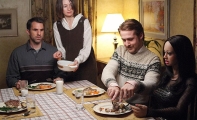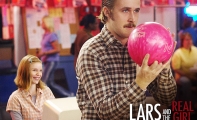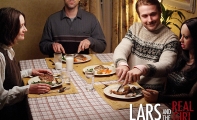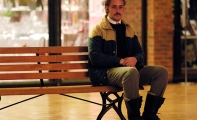Lars and the Real Girl (2007)
Synopsis
Lars is a 27-year old misfit who lives alone in a garage and mostly keeps to himself. His mother died while giving birth to him, his father kept to himself, and now, relating with humans is fraught with danger. To overcome his challenges, Lars orders a plastic girlfriend from the Internet and pretends that she is real. This is a moving story about the goodness in human beings and the power of symbols, love and compassion as healing agents. And if you look closely, you’ll find clues to the importance of being initiated into manhood, the sacred ritual our culture lost.
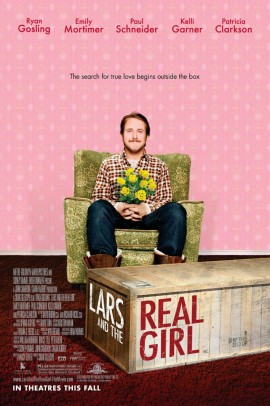
| Genre | Comedy |
| Production year | 2007 |
| Director | Craig Gillespie |
| Male actors | Ryan Gosling, Paul Schneider |
Mother, where are you?
by Eivind Figenschau Skjellum
Lars Lindstrom is a shy 27-year old, living in the decrepit garage next to his childhood home, now the abode of his brother Gus, his wife Karin, and their unborn baby. Despite their closeness – mere footsteps apart, they share little intimacy. Lars can’t handle it; he’s sickly shy, and afraid of all human relations – especially the touch of naked skin. But Lars has a big heart, and Karin cares for him deeply, as do most people in their little community in the North. She longs to bond with him, hoping perhaps to bring blood brothers separated by difficult childhood circumstances back together.
Lars works as an office drone in a nondescript company, where he shares booths with an immature action figure- and porn-afficionado called Kurt (“the uninitiated”). It is Kurt who clues Lars in on Real Dolls, a range of realistic, life-size love dolls. Six weeks later, a big box is delivered to Lars’s garage. Plastic love has arrived at the Lindstrom’s.
But to Lars, the «Real Doll» Bianca is not merely a doll, it is – she is – his Brazilian-Danish missionary girlfriend freshly arrived from the airport, sans luggage. Then the strangest thing happens, Lars invites himself over for dinner. Lars has avoided any sort of connection with his brother and sister-in-law previously to this; in fact Karin is in one scene shown tackling him and pinning him to the ground to get a clear answer as to why he won’t come over.
But now he stands proudly and sure of himself on their doorstep, and the promise of change lights up the crisp, cool night. And so it happens that Bianca arrives on the couch of the Lindstrom brothers’ childhood home – in all her mute, inanimate splendour, leaving Karin and Gus absolutely horrified. Their first introduction to Lars’s new-found love is both extremely funny and profoundly moving. «My brother is insane! What are we gonna do?», Gus exclaims.
He finds the situation just a little bit more uncomfortable than Karin does, who – perhaps due to motherly instincts, perhaps due to female intuition – takes to the situation with care and understanding, going so far, even, as to serve the sex doll sitting at her dinner table food.
Caring for Bianca
Bianca is, according to Lars, a very religious person, so he feels it highly improper for her to stay in the garage with him. He wants her to sleep in his mom’s old room. The room is bright pink, womblike and smelling subtly of a time that is no more, of stories that were once told, before Lars’s violent entry into the world stopped the voices all too soon. There is something moving deep in Lars’s psyche as he puts Bianca in that bed, spreading the sheets over her in the very same place where his mother, the mother whose death he clearly feels responsible for, dreamt her dreams.
Dr. Dagmar is the general practitioner and psychologist, a wise and soft woman with a very strong, almost enigmatic, presence, who tells Karin and Gus that they have to go along with Lars’ delusion. «Delusion? What the hell is he doing with a delusion, for Christ’s sake?!?!», screams Gus. «Bianca is in town for a reason,» Dagmar points out. «Go along with it. It’s not really a choice.» After some challenging first encounters for the members of the local community with Lars’s dream made manifest, everyone teams up, in spectacular fashion, to support Lars’s view of Bianca as a real human being.
Soon enough, Bianca is engaged in all kinds of roles in the local community. She volunteers at the hospital, models at the local clothes store, «reads» for children. Bianca is popular, pretty much fully booked in fact, and Lars sees less and less of her. This upsets him and in one scene, he starts «fighting» with Bianca in the pink room. He is, for the first time, starting to break with his fantasy, laying his guilt to rest.
Inheriting our parents
I think this is a pertinent time to go deeper into the theme of parents, their role, and the deeper energies they represent, which I believe is one the movie’s thematically strongest undercurrents (the other being healing). Lars’s mother died giving birth to him. After she died, his father withdrew into himself, into a dark and lonely realm of introversion and apathy. That’s the father Lars knows, but he wasn’t always like that, Gus discloses to him in one scene. That doesn’t make matters better.
It’s likely that Lars not only feels responsible for the death of his mother, but that he feels the stain of his father’s emotional and spiritual death as well. Lars, essentially, feels responsible for having killed off both of his parents, and now he is convinced that his existence poses a threat to life, which is ever so fragile.
Lars had no real parents, no figures of authority, no-one to receive love or guidance from. Gus fucked off as soon as he could because it felt so painful to live at home after mother died, and Lars was left to fend for himself. He was alone. It is generally understood that children feel responsible for their parents’ safety and happiness. Things being what they are, Lars is so laden with guilt and has been decomposing for a long time. His reclusive lifestyle, then, is likely his way of protecting others from himself, offering – in a strange sort of way – his surroundings a form of safety that he never had.
Lars’s incredible discomfort with human touch is noteworthy. There is a bodily connection between the unborn son and the pregnant mother. When we are born, it stays with us for a long time. It gives rise to such phenomena as Oedipus syndrome, the desire to «kill dad» to have mother for ourselves. Some guys never sever the emotional-energetic umbilical cord to mother. Actually in today’s culture, I venture to say – on danger of offending – that most guys never fully sever that cord.
Robert Bly speculates as much in his seminal classic Iron John. We tend to remain with an idealized notion of the transcendent beauty and perfection of feminine purity, such an amazing sight of splendour that we, in pure reverence, withhold our dark and dirty masculine sexual instincts from it.
It is a common complaint among modern women, not so much that many men give them dirty looks or approach them in sleazy ways, but that they give no looks at all, make no attempts to win them over at all. The reason is we are trapped in our idealization of our mother, afraid of a father that feels dark and inaccessible, afraid of the masculine force in ourselves. Adulthood for a man only happens when he is initiated into that scary place of the father and the energies he represents.
But initiation requires not only something to be initiated into, but something to be initiated out of, which for men is the attachment to mom. We must “retrieve the key to the wild man from under mother’s pillow”, as Robert Bly describes it. So prior to the initiation into the masculine, what happens if the feminine, the mother, is absent?
Lars reaches out to the feminine
To get clues to help us answer this question, let’s look closer at four key relationships Lars has to women.
Bianca
Bianca is strictly speaking not a woman, but represents his most important feminine connection, by virtue of what she symbolizes. Bianca is clearly not meant for Lars’s carnal pleasure. Bianca, rather, seems to be the object of affection that Lars needs to connect with the mother he never had. He puts her in his mother’s room, and idealizes her many good qualities, «born to help people», as Lars would have it in one scene.
But being what she is, Bianca cannot offer him maternal, nurturing instincts. So instead, Lars projects his mother into the doll, and devotes himself with feverish intensity to taking good care of her. He is making up for his tremendous, heart-wrenching feelings of guilt by serving the good health and happiness of a plastic love doll.
Karin
Karin – Gus’s wife – is about to give birth to their first child. This is incredibly disconcerting to Lars. It brings back into focus for him his first screams of life, and the haunting sensation that they blend ever so perfectly with his mother’s screams of death. In this relationship there is a blanket, the blanket Lars’s mother made for him during her pregnancy – Lars’s dearest possession – that carries great symbolic weight. For Lars, it is a symbol of maternal love, and he uses it to protect Karin and her child from the cold.
Dagmar
It is with Dr. Berman – Dagmar – that Lars for the first time connects with a living mother figure. Dagmar is a wise and mature woman, with great love for Lars, oodles of insight and lots of skillful means. She is pretty kick ass. She helps Lars reconnect with his body, the very body that killed his mother, by taking him through progressive training in being touched. He serves him greatly in return; Dagmar is a lonely woman, without children, and so – in her heart – she virtually adopts Lars as her own infant son, helping him become the young man that she misses in her own bloodline. There is great love here.
Margo
Then, of course, there is Margo, the new girl at work and Lars’s actual love interest. Margo is shy and insecure like Lars, but very likable and sweet. They are a good match, as receptionist Cindy points out. But Lars is not ready for real love yet. He feels he is too dangerous. Margo may die, and so he must remain with Bianca, the plastic girlfriend. But it is she who must die.
What it means to be a man
In a funny and decidedly twisted turn of events, Lars asks Bianca to marry him, and she says no. Shortly after – curiously lighthearted considering Bianca’s refusal – the increasingly free Lars approaches Gus and tells him how in Bianca’s culture, they have rites of passages and rituals and ceremonies, that when done – when lived through – you know you are an adult. «Doesn’t that sound great?», Lars asks. Now, right here, I light up like a 100 watt light bulb during a power surge. Doesn’t that sound great? Yeah, it sure does.
Lars has clearly studied these things – Bianca obviously doesn’t talk – and now, he seeks initiation into adulthood. «How did you know» Lars asks Gus «that you were a man? Was it sex?». Actually, Gus doesn’t know. He is not in a confident space now, because he has not been initiated either. Modern men, as a rule, are not initiated into manhood, which leaves a huge empty space between the neck and the lower belly (as described by Robert Bly in a «personal fable» in Iron John).
Gus is a good guy, but has some way to go before being anchored in his own masculine core, which is there – somewhere in the middle. «Go ask Dagmar,» Gus suggests. As if a woman should have the answers to male initiation. This is a subtle hint to how trapped and confused men in today’s culture feel: Even when confronted with questions of their core masculinity, their biological and spiritual homebase, they refer to female mother figures for answers.
But Lars presses him, until Gus finally yields to Lars into his own inner wisdom and shares that being a man is working for the common good, not for your own selfish desires – even if it hurts. Gus is a smart guy, who has realized by now that his leaving home early has caused damage to Lars. In searching for answers and healing, Lars’s journey opens up a space for Gus, and indeed the rest of the community, to heal.
The alchemy that turns plastic into flesh
Bianca’s rejection of Lars’s proposal means that Margo can get closer to him. Real life is increasingly tempting to the rapidly healing young man. So they go bowling together. Here, for the first time in the movie, Lars connects – not through Bianca, but on his own – with the colour pink, picking up a bowling ball covered in bright, girly pink hues. It is as if he integrates the feminine, he embraces mother, he holds her in his hand (have a look at the movie poster to understand more deeply the importance of the colour pink as a symbol for mother).
Shortly after, a group of guys enter the bowling alley – Gus’s colleagues – and join in. Lars is on a date, and now he is one of the guys too. He is healing. It is time for Bianca to die.
At the lake where Lars’s childhood memories still linger like a haunting dream about a life that could have been, he kisses her for the first time. She is ill, very ill. She is going to die. Lars is finally ready to let mum get down from his own weary shoulders and sink silently into the soil, finally there to rest in peace. With the deep hurt of feeling into a mother he never knew, and misses so incredibly much, guilt leaves his body – rivers of release through his eyes – as he carries the dead Bianca into the water.
She’s returning to the womb, to the place of fantasy where she came from. In her funeral, he wears her pink sweater; mother has been resurrected and put back into her grave, leaving Lars with feelings of love he never had.
Lars’s alchemy of the heart has freed him from the bondage of guilt, and led him to a place where he can, for the first time, from a more integrated place, embrace the positive aspect of being initiated into manhood. A wave of confidence and determination washes over his face as he turns to Margo, looks into her eyes and asks «Do you want to go for a walk?»
Conclusion
Lars and the Real Girl is a moving, caring and wise movie. Just like in the extremely likable Sideways, it portrays human beings in a positive light, operating in a world where people try to be good. It also, rather obviously, deals with questions of what constitutes a good healing process for those with psychological «illness» – medication, or love and compassion. It could even be argued that it asks «what is psychological illness». Could it be that the psychologically ill can sometimes be saner than the so-called well adjusted?
More subtly, the movie points to the importance of integrating, as we move into adulthood, the broken shards that remain from our childhood through any means necessary, which normally means examining our parents and our relationships with them. As human beings, we have a tendency to feel that we’re doing okay, until circumstances point out that we’re fooling ourselves. Life is inherently tricky and is inherently fragile, and the sooner we accept this, the sooner we will accept that our strength is sourced in our vulnerability. And that, my friends, is where initiation comes in…


